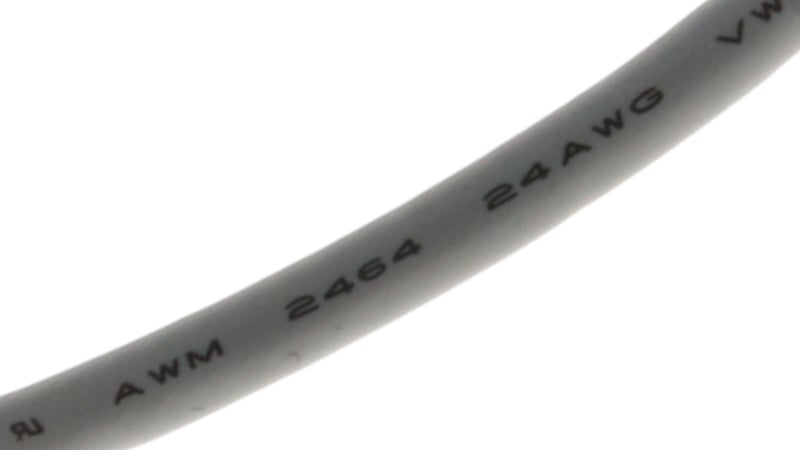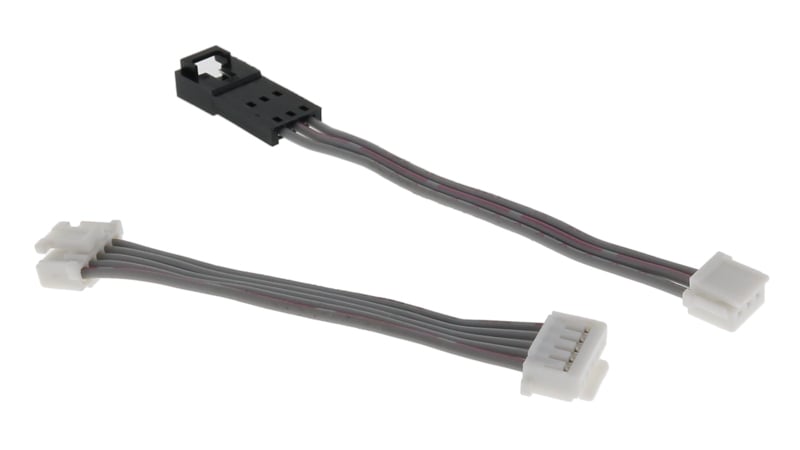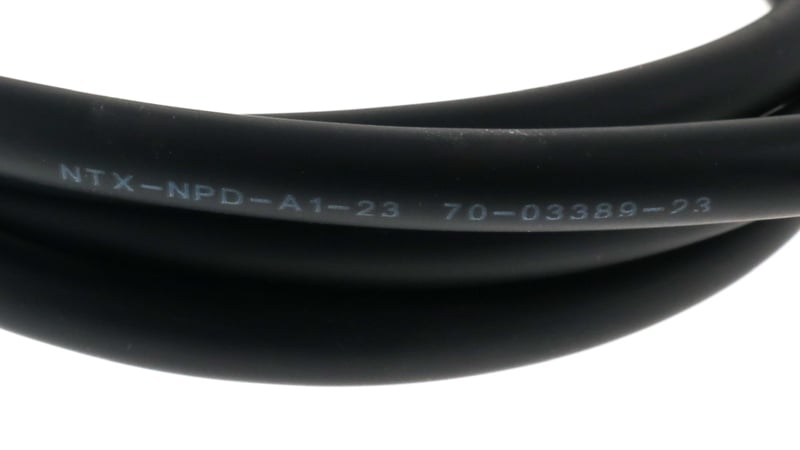Printed text and other markings along wire jackets serve multiple purposes. What may appear as gibberish text on the outside of a cable is likely meaningful information that can be used to quickly determine the wire size, voltage rating, and the relevant industry certifications that the cable meets.
Most UL-approved hook-up wiring and multiconductor cables have standard information that is printed along the wire jacket. Upon request and with an added cost, branding information and other product-specific markings may be added directly to the wire. As long as minimum order quantities are met for custom runs of wire; the printed text can be completely customized or omitted entirely leaving a blank cable jacket that is free of text.
Standardized Wire Markings
Spread in a repeating pattern along the length of the cable, agency approvals can be identified by the four- or five-digit number sequences starting with “1” or “2”. Usually following Appliance Wiring Materials (AWM), the UL agency approval serves as a third-party certification affirming the general construction of the wire. Information such as the material type, conductor count, temperature rating, voltage rating, flammability rating, shielding methodology, and even jacket wall thicknesses are all defined by this agency approval. Most importantly, using UL-approved wire can eliminate the need for additional testing and flammability studies that would otherwise add significant cost and time to new projects.
Breaking Down Standard Wire Markings

Common wire jacket markings.
UL Recognized Component Mark
Viewed as a backwards “UR”, this mark is printed along the wire jacket to symbolize that the cable is certified for use as a part of a larger system. Cable assemblies that have this mark are intended to be installed in some next higher assembly. Having the “UR” mark indicates that the wire is covered by the UL Recognized Component program simplifying the certification process.
Appliance Wiring Materials
UL 758 defines the broad range of products that may be deemed Appliance Wiring Materials. Printed as “AWM”, this mark typically precedes the wire’s UL approvals along the outer jacket. Most discrete cable harnesses that are used within electronics assemblies and other enclosure types fall within the appliance wiring designation.
UL Rating
UL 2464 and UL 2517 are among the most common ratings for multiconductor cables. Other UL ratings cover single conductor wire and comply with specifications such as UL 1007 and UL 1061. Each UL rating has its own unique combination of jacket material, voltage rating, temperature rating, and overall construction.
Wire Size
American Wire Gauge (AWG) corresponds to the cross-sectional area of the wire’s center conductor. Since a wire’s current-carrying ability depends on the wire gauge, selecting the proper AWG size is critical for proper system function. The majority of hook-up wiring ranges from 16AWG to 28AWG. Globally, wire size is also defined by mm2, which is its millimeter cross-sectional area. Tables are available for reference showing both AWG and the corresponding metric equivalent.
Flammability Standards
A wire’s copper conductor is not flammable, but its jacket and insulation can be, and they may burn when exposed to direct flame. Regulators have established flammability limits for cable jacketing to help prevent electrical fires and minimize their spread. VW-1 is one of the most common UL and CSA flammability standards and corresponds to a vertical flame test classification.
High-Temperature Limits
The maximum allowable temperature limits are printed along the jackets of most UL-approved wires. The ratings, shown in degrees Celsius, range from 80°C to 105°C, to 150°C or higher and depend on the jacket material and its thickness. For temperatures above 200°C, specialty jacket constructions must be necessary.
Voltage Rating
While approved for both direct current and alternating current applications, the maximum voltage is printed along most wire jackets in compliance with UL marking requirements. Ranging from 30V to 150V, to 300V, to even 600V, a cable’s voltage rating is a function of the jacket material and its thickness.
Customized Ribbon Cable Wire Markings
Ribbon cables are a low-cost and simple cable construction that is built by spreading all conductors into a flat single plane. With all wire jackets fused along their edges, the shape resembles the cross-section of a ribbon which allows for flexing and movement with minimal damage. Ribbon cables are ideal for low complexity design applications where space is limited, and costs are a concern. Ribbon cables are simple to work with since the conductors can be easily identified, with PIN 1 being clearly marked even when up to 50 conductors are needed.
Since most ribbon cables are rainbowed with a 10-color repeating pattern, or gray with a red mark to indicate PIN 1, ribbon cables are not usually considered for customization. If minimum order quantities are met, custom ribbon cables can be extruded with the exact combination of wire colors requested. Furthermore, custom text and printed markings can be included to support program objectives. This means that adding additional red stripes or markings to an otherwise plain gray ribbon cable is a realistic option.

Gray ribbon cable extrusion with specialty red markings.
Custom Text Printed Along Wire Jackets
Adding text to the outer jacket of cables is straightforward as long as minimum order quantities are met. Customized text is printed along the outer surface of the cable jacket in a repeating pattern and applied along the entire length. The pitch of the text, which is the vacant space from where one section of text stops and the next begins, can vary based upon customer requirements. Defining the pitch can help ensure there is adequate spacing for markings along the cable jacket, helping improve the readability of the printed information.

Custom pitch spacing of printed text.
Any font or character can be used as long as the information is provided in vectorized artwork format. But if the font or characters are not critical, offering cable manufacturers flexibility to use common fonts, sizes, and formats will help reduce the overall risk of a project. It’s important to note that the entire run of wire will have these wire markings, and unique printed markings between cables will warrant a completely new batch and drive an additional minimum order quantity.

Custom markings printed along cable jacketing.
Summary
While the majority of electrical wiring and cable assemblies do in fact have text printed along their outer jackets, there are plenty instances where it makes sense to have a bare jacket free of text. Guitar patch cords that connect the instrument to an amplifier are known for their smooth black finish, which is free of distracting text. On the other hand, HDMI cables must be marked to show they are able to properly render video and that their construction is compliant with HDMI standards. Either way, dedicated runs of wire are necessary to implement customization since applying the text is done during the final step of the extrusion and spooling process.
If markings are needed on a cable after it’s terminated, adding labels is one option to consider. If custom overmold tooling is planned, another option to consider is adding artwork and brand markings to the overmolded strain relief. Early engagement with a full-service manufacturing partner like Epec can help review design nuances before they become program risks with the potential to impact cost and deliveries.
Key Takeaways
- Purpose of Printed Wire Markings: Text along cable jackets provides quick, essential information such as wire gauge (AWG), voltage and temperature ratings, flammability classification (like VW-1), and industry certifications (e.g., UL AWM, CSA).
- UL Recognized Component & AWM: The “UR” symbol means the cable is UL-recognized for integration into higher assemblies. The “AWM” designation under UL 758 identifies Appliance Wiring Materials, defining construction standards and reducing the need for extra testing.
- Customization Options: Manufacturers can add custom branding, program-specific identifiers, or other markings to wire jackets if minimum order quantities are met. This includes adjusting the pitch (spacing between printed text) and using customer-specified fonts or artwork.
- Ribbon Cable Marking: Ribbon cables, typically in rainbow or gray with a red PIN 1 stripe, can also be customized with different colors, additional stripes, or printed text if project volumes justify custom extrusion runs.
- When to Omit Markings: Not all cables require visible markings. For example, guitar patch cords often feature a clean jacket for aesthetic reasons, while HDMI cables must include compliance markings. If post-production marking is needed, options include adhesive labels or adding artwork to overmolded strain reliefs.
















